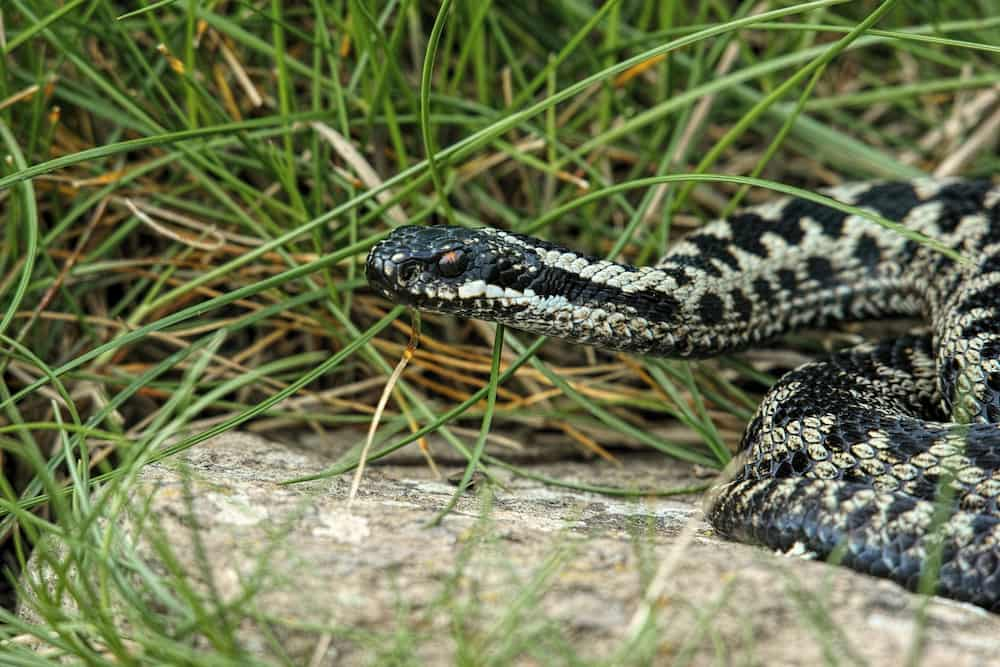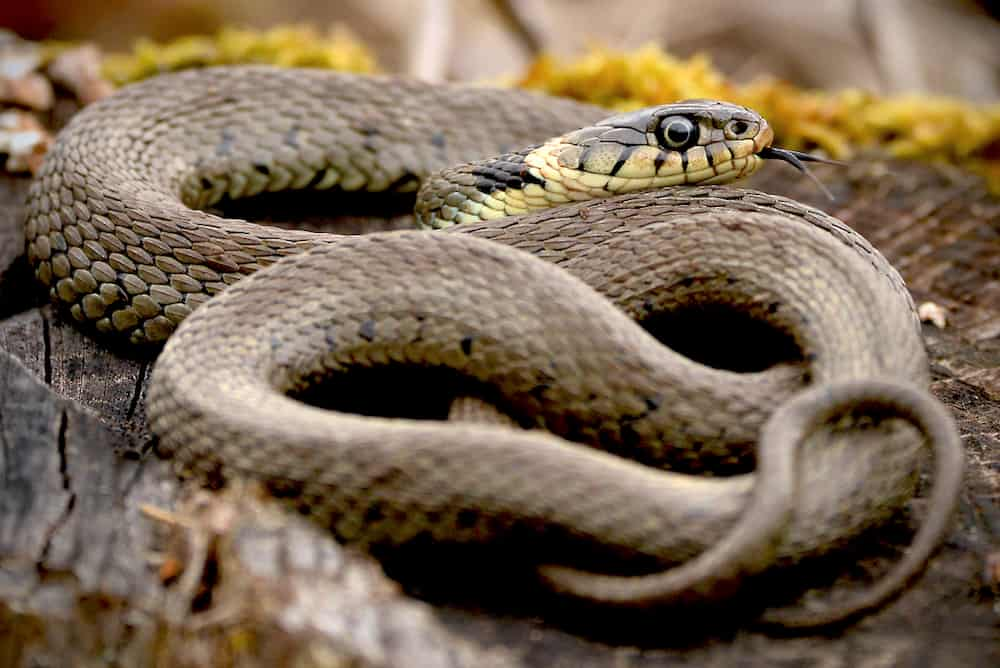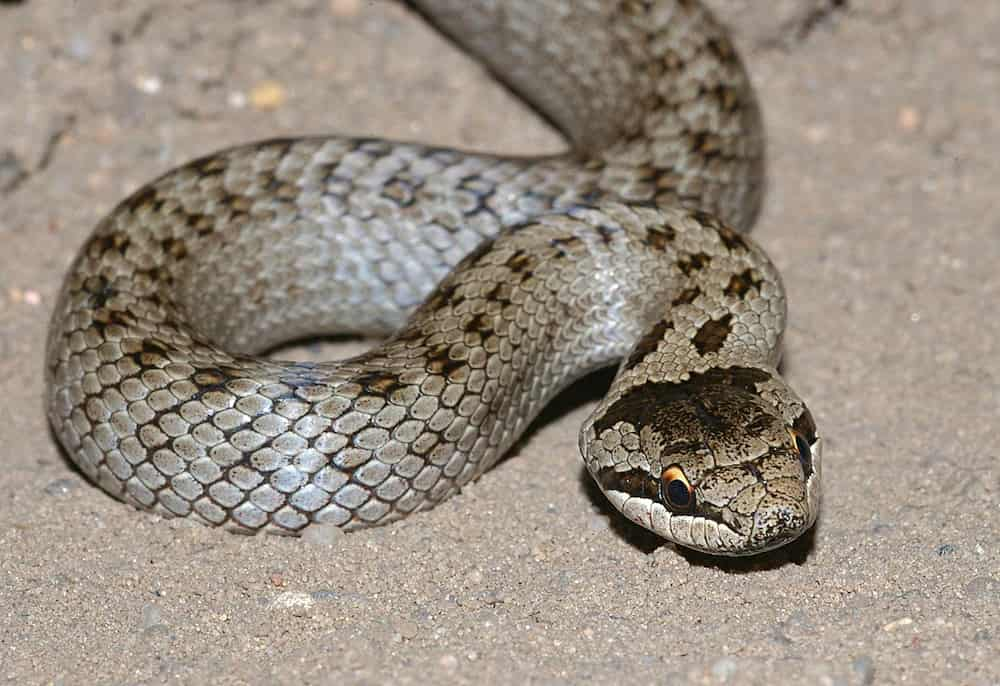Wild snakes are not common in Norway, with only a few species inhabiting the southern regions of the country.
That said, it’s true that there are snakes in Norway so it’s good to be aware of what you may encounter, especially if you’re planning a hiking trip or forest walk – just in case you stumble across one slithering across your path.
So keep reading to find out more about the snakes of Norway – as well as the other Nordic countries!

Table of Contents
Are there snakes in Norway?
Yes, there are three types of snakes in Norway, although they are not very common. The most common snake is the European adder (Vipera berus), which is the only venomous species found in Norway. Other snakes include the European grass snake (Natrix natrix) and the European smooth snake (Coronella austriaca).
One common point of confusion arises with the deaf adder (Anguis fragilis), which looks like a snake. However, it’s actually a legless lizard.
I’ve got a bit more information on the snakes that live in Norway below, so you know what to look out for, including to tell them apart.
1. European adder
The European adder (Vipera berus) – or “Hoggorm” in Norwegian – is the most common snake in Norway and is also the only venomous snake found in the country. It is a relatively small snake, usually growing to be about 60 cm to 90 cm (24 inches to 35 inches) long.
European adders are typically light to dark brown in color with dark brown or black zig-zag patterns running down their backs.

Interestingly, they’re one of the few types of snakes where males and females have different coloring. Males are generally completely gray with black markings, while females are browner with dark brown markings running down their body.
They can be found in a variety of habitats, from rocky hillsides to wetlands, although you’re unlikely to see one. This is because adders are generally shy snakes and will try to avoid contact with humans whenever possible. Most bites occur when people try to pick them up or step on them – so, safe to say, try not to do either of those things.
Keep in mind: If you do encounter an adder, it is important to stay calm and not startle the snake. Although their venom is not usually deadly to humans (although is more dangerous for young children), an adder bite can still be painful and cause swelling and bruising.
If you are bitten by an adder, it is important to seek medical attention immediately.
2. European grass snake
The European grass snake (Natrix natrix) – known as “Buorm” in Norwegian – is a non-venomous snake that is found in Norway, although it is not very common. It is a relatively large snake, often growing to be about 1.5 m (5 feet) in length.
Grass snakes are typically dark green or brown in color with dark brown stripes running down their backs. They are often mistaken for adders due to their similar coloring.

In terms of their preferred habitats, you’ll often find grass snakes on the edges of fields or forests, but they also like to be near water, such as marshes, ponds, and wetlands, including on various Norwegian islands. They are good swimmers and often eat amphibians, fish, and small mammals.
Grass snakes are generally shy and not aggressive towards humans, although they do have a defensive mechanism similar to cobras in that they can rise up and flatten their head and neck. Bites are rare and they aren’t poisonous, but you should still seek medical attention if you are bitten.
Did you know: To defend themselves, grass snakes can produce a garlic-smelling fluid. They also may pretend to be dead by going completely limp and by secreting blood from their mouth and nose.
3. European smooth snake
The European smooth snake (Coronella austriaca) – called “Slettsnok” in Norwegian – is a non-venomous snake that is found in Norway, although it is not very common. It is a relatively small snake, usually growing to be about 60 cm (24 inches) long.
Smooth snakes are typically gray or brown in color with dark brown or black spots running down their backs. They can be found in a variety of habitats, but prefer areas with dense vegetation.

You’ll find that smooth snakes are generally timid and will try to avoid contact with humans whenever possible. Of course, as with all snakes on this list, if you do encounter a smooth snake in Norway (or anywhere), it is important to stay calm and not startle the snake.
Take note: Although they are not venomous, smooth snake bites can still be painful. If you are bitten by a smooth snake, it is important to seek medical attention immediately.
Does Norway have venomous snakes?
Yes, Norway has one type of venomous snake, the European adder (Vipera berus). The European adder is the most common snake in Norway although it is very shy so bites are rare, usually only occurring if the snake is startled or feels threatened in some way.
It is important to seek medical attention immediately if you are bitten by the European adder. Deaths are rare – for instance, there were only 14 known fatalities in Britain between 1876 and 2005 from this snake – but they can occur. A bite can be particularly dangerous for small children or elderly people.
You’ll certainly feel if you are bitten, as a bite will usually be followed by immediate and intense pain. A few minutes later (but perhaps by as much as 30 minutes) you’ll often experience swelling and a tingling sensation.
Symptoms can get worse so seek medical attention straight away.
Are there snakes in Nordic countries?
There are three types of snakes that can be found in the Nordic countries: the European adder (Vipera berus), the European grass snake (Natrix natrix), and the European smooth snake (Coronella austriaca). The European adder is the only venomous snake of the three.
As outlined above, all three snakes are relatively shy and not aggressive towards humans. If you do encounter any of these snakes though, it is important to stay calm and not startle them.
If you are bitten by any of them, even if only the European adder is venomous, it’s important to get to a doctor straight away.
Interestingly, the European smooth snake isn’t found in Denmark, despite it living just south of the German border and in southern Sweden, both of which are very close to Denmark. The last specimen of this species found in Denmark was in 1914.
You may also be interested in: Do Bald Eagles Live in Norway – or Even in Europe?
Why are snakes not common in Norway?
The reason that snakes are not common in Norway is because the climate is too cold for them to survive. Snakes are ectothermic, meaning that they rely on external sources of heat to regulate their body temperature and so Nordic winters aren’t ideal for them.
That is, in the Nordic countries, winters are long and harsh, and there are not many places for snakes to find shelter from the cold weather.
In fact, other parts of the region such as Iceland and Greenland do not have any snakes at all, because they are too far north for snakes to be able to survive.
Another reason why snakes are not common in Norway is because there is an abundance of other predators that would eat them.
Wolves, lynxes, and eagles are all common predators in Norway, and they would have no problem preying on snakes. In fact, these predators help keep the snake population in check by keeping their numbers low.
So if you’re ever planning a trip to Norway or any of the other Nordic countries (perhaps during blueberry season in Norway…) and you’re worried about encountering snakes, don’t worry – while there are snakes in Norway (and the rest of Scandinavia), you’re unlikely to see one!
